|
|
|
Sort Order |
|
|
|
Items / Page
|
|
|
|
|
|
|
| Srl | Item |
| 1 |
ID:
142786
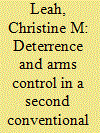

|
|
|
|
|
| Summary/Abstract |
Neither further nuclear reductions nor total nuclear disarmament are necessarily smart ideas, but proponents of these goals insist that we should move toward a second conventional age, in which nuclear weapons are either marginalized or completely removed from international politics. But in this world, deterrence and extended deterrence might not endure without boosting aspects of conventional arsenals. How might the U.S. deter adversaries and assure allies? The answer ultimately rests on conventional forces, especially long-range ballistic and cruise missiles. But these would have to be deployed in greater numbers to compensate for a “nuclear gap.” This might lead to a destabilizing arms race.
|
|
|
|
|
|
|
|
|
|
|
|
|
|
|
|
| 2 |
ID:
103814
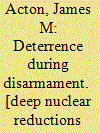

|
|
|
|
|
| Publication |
London, International Institute for Strategic Studies, 2011.
|
| Description |
128p.
|
| Series |
Adelphi Paper, 417
|
| Standard Number |
9780415681827
|
|
|
|
|
|
|
|
|
|
|
|
Copies: C:1/I:0,R:0,Q:0
Circulation
| Accession# | Call# | Current Location | Status | Policy | Location |
| 055904 | 355.825119/ACT 055904 | Main | On Shelf | General | |
|
|
|
|
| 3 |
ID:
104633
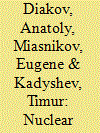

|
|
|
| 4 |
ID:
142790
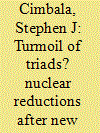

|
|
|
|
|
| Summary/Abstract |
The United States and Russia have options for resuming their strategic nuclear arms reductions, should more favorable political circumstances present themselves. Both share a responsibility for leadership in the global nonproliferation regime, and both the U.S. and Russia will face future trade-offs between domestic economic priorities and nuclear force modernization. Analysis suggests that reductions to a maximum number of 1,000 deployed nuclear weapons on intercontinental launchers for each state should allow for sufficient numbers of second-strike-survivable weapons for stable deterrence. Below that number, either the U.S. or Russia might feel a sense of insufficient flexibility and resilience in its strategic nuclear forces, and in addition, reductions significantly below 1,000 deployed weapons would require the participation of other nuclear weapons states.
|
|
|
|
|
|
|
|
|
|
|
|
|
|
|
|
| 5 |
ID:
144765
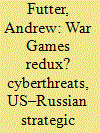

|
|
|
|
|
| Summary/Abstract |
Some 30 years since the release of the Hollywood blockbuster War Games, the possibility that hackers might break into nuclear command and control facilities, compromise early warning or firing systems, or even cause the launch of a nuclear weapon has become disturbingly real. While this challenge will impact all nuclear-armed states, it appears particularly acute for the USA and Russia given their large, diverse, and highly alerted nuclear forces. The fact that east–west relations have deteriorated to a nadir perhaps not seen since the 1980s, strategic instability has increased – particularly in the wake of the Ukraine and now Syria crises – and that the nuclear arms reductions agenda appears to have reached a standstill makes this challenge particularly pressing. In this discouraging milieu, new cyberthreats are both exacerbating the already strained US–Russia strategic balance – particularly the perceived safety and security of nuclear forces – and at the same time creating new vulnerabilities and problems that might be exploited by a third party. Taken together, these dynamics add another major complication for current arms control agreements and possible future nuclear cuts, and also seem likely to increase the possibility of accidents, miscalculation, and potential unauthorised nuclear use, especially given the large number of nuclear weapons that remain on “hair-trigger” alert.
|
|
|
|
|
|
|
|
|
|
|
|
|
|
|
|
|
|
|
|
|